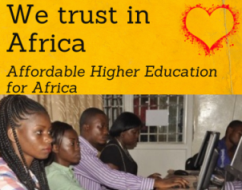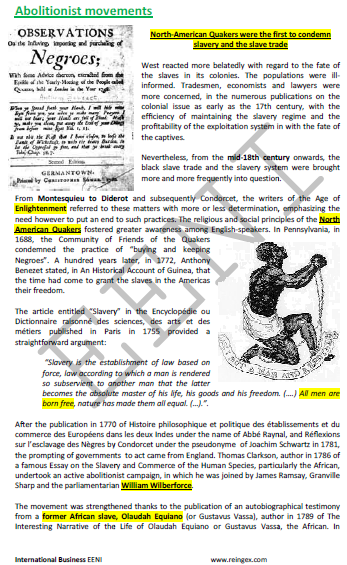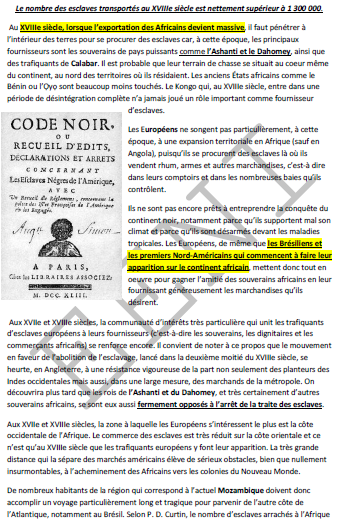Abolition of Slavery. Quakers
Abolitionist movements, Harriet Tubman, Toussaint-Louverture, Wilberforce

American Quakers were the first to condemn Slavery and slave trade.
Some protagonists of abolitionism:
- Quakers
- William Wilberforce
- Harriet Tubman
- Frederick Douglass
- Victor Schoelcher
- Olaudah Equiano, an African slave and author of an autobiography (1789)
- Society of the Friends of the Blacks (Paris, London - 1787)
- Slaves of Santo Domingo (French colony). 1793: Abolition of Slavery. Toussaint Louverture
- Haitian Revolution
- Henry David Thoreau
Sample - Abolition of Slavery

Three key economic factors:
- Adam Smith (British economist): a free worker is more profitable than an slave
- European competition of sugar-cane
- Opening of Asian markets (England)

The Subject “Abolition of Slavery. Abolitionist Movements” is included within the curriculum of the following academic programs at EENI Global Business School:
Doctorate in African Business, Ethics, Religion & Business.


Languages:  or
or  Abolition Esclavage
Abolition Esclavage  Abolição da Escravatura
Abolição da Escravatura  Abolicion Esclavitud.
Abolicion Esclavitud.

Chronology of the abolition:
The abolition of Slavery lasted two hundred years, beginning in 1793 in Santo Domingo. The last country to abolish slavery in 1992 was Pakistan.
- Santo Domingo (1793)
- United States. 1794: Prohibition of slave trade (ineffectively). 1863: Abolition of Slavery. 4 millions slaves released
- England. 1807: prohibition of slave trade. 1833: emancipation of slaves (Abolition Bill)
- Foundation of Sierra Leone (1787)
- Denmark (1803). Entered into force in 1848
- Haiti: 1804
- Trafficking in slaves continued (United States, Brazil, colonies of the Caribbean)
- Prussia (1807)
- Netherlands (1814)
- Congress of Vienna (1815)
- Santo Domingo (1822)
- Foundation of Liberia (1822) by the United States with released Blacks
- France (1848): Decree of suppression of slavery. Victor Schoelcher
- Canada (1834 - Abolition)
- Latin America. Black slaves recruited as soldiers to fight against Spain: Venezuela (1816, Simon Bolívar), Cuba, Chile (1823)
- Costa Rica, Honduras, Panama, Belize, El Salvador, Guatemala (1824)
- Bolivia (1826)
- Mexico (1829)
- Nicaragua (1836)
- Uruguay and Paraguay (1842)
- Tunisia (1846)
- Danish Virgin Islands (1846)
- Martinique, Guadalupe, French Guyana, Reunion (1848)
- Brazil (1850). However, trafficking in slaves continued until 1888
- Colombia and Ecuador (1851)
- Argentina (1853)
- Venezuela, Jamaica and Peru (1854)
- Russia (1861)
- Spain (1866)
- Portugal (1869)
- Puerto Rico (1873)
- Turkey (1876)
- Cuba (1886)
- Korea (1894)
- Madagascar (1896)
- Kenya (1907)
- China (1910)
- Morocco (1922)
- Afghanistan (1923)
- Nepal (1926)
- Iran (1928)
- Bahrain (1937)
- Ethiopia (1942)
- Kuwait (1949)
- Qatar (1952)
- Saudi Arabia and Yemen (1962)
- Oman (1970)
- Mauritania (1981)
- Pakistan (1992)
United Nations.
- Universal Declaration of Human Rights (1948)
- Convention for the Suppression of the Traffic in Persons and Exploitation of Prostitution of Others (1949)
- Supplementary Convention on the Abolition of Slavery (1956)
- Working Group on Contemporary Forms of Slavery (1974)
The UN and the International Labour Organization (ILO) consider that contemporary slavery and forced labour, particularly of children, affecting at least 200 to 250 million people.
The Volume VI (Africa in the 19th century until 1880) of the History of Africa analyze the abolition of Slavery.

(c) EENI Global Business School (1995-2025)
Top of this page









 WhatsApp
WhatsApp